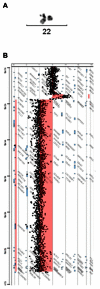Clinical and molecular characterization of a patient with a combination of a deletion and a duplication of 22q13 using array CGH
- PMID: 23776384
- PMCID: PMC3681196
- DOI: 10.2147/TACG.S35799
Clinical and molecular characterization of a patient with a combination of a deletion and a duplication of 22q13 using array CGH
Abstract
Phelan-McDermid syndrome is caused by the loss of terminal regions of different sizes at 22q13. There is a wide range of severity of symptoms in patients with a 22q13 deletion, but these patients usually show neonatal hypotonia, global developmental delay, and dysmorphic traits. We carried out a clinical and molecular characterization of a patient with neonatal hypotonia and dysmorphic features. Array-based comparative genomic hybridization showed an 8.24 Mb terminal deletion associated with a 0.20 Mb duplication. Characterization of patients with Phelan-McDermid syndrome both clinically and at the molecular level allows genotype-phenotype correlations that provide clues to help elucidate the clinical implications.
Keywords: 22q13 deletion; Phelan-McDermid syndrome; genotype-phenotype correlations; subtelomeric rearrangements.
Figures


Similar articles
-
Association between deletion size and important phenotypes expands the genomic region of interest in Phelan-McDermid syndrome (22q13 deletion syndrome).J Med Genet. 2011 Nov;48(11):761-6. doi: 10.1136/jmedgenet-2011-100225. Epub 2011 Oct 7. J Med Genet. 2011. PMID: 21984749
-
A patient with the classic features of Phelan-McDermid syndrome and a high immunoglobulin E level caused by a cryptic interstitial 0.72-Mb deletion in the 22q13.2 region.Am J Med Genet A. 2014 Mar;164A(3):806-9. doi: 10.1002/ajmg.a.36358. Epub 2013 Dec 20. Am J Med Genet A. 2014. PMID: 24375995
-
22q13.2q13.32 genomic regions associated with severity of speech delay, developmental delay, and physical features in Phelan-McDermid syndrome.Genet Med. 2014 Apr;16(4):318-28. doi: 10.1038/gim.2013.144. Epub 2013 Oct 17. Genet Med. 2014. PMID: 24136618
-
Genotype-phenotype correlation in Phelan-McDermid syndrome: A comprehensive review of chromosome 22q13 deleted genes.Am J Med Genet A. 2021 Jul;185(7):2211-2233. doi: 10.1002/ajmg.a.62222. Epub 2021 May 5. Am J Med Genet A. 2021. PMID: 33949759 Free PMC article. Review.
-
A previously unrecognized 22q13.2 microdeletion syndrome that encompasses TCF20 and TNFRSF13C.Am J Med Genet A. 2018 Dec;176(12):2791-2797. doi: 10.1002/ajmg.a.40492. Epub 2018 Sep 14. Am J Med Genet A. 2018. PMID: 30216695 Review.
References
-
- Phelan MC, Rogers RC, Saul RA, et al. 22q13 deletion syndrome. Am J Med Genet. 2001;101(2):91–99. - PubMed
-
- Havens JM, Visootsak J, Phelan MC, Graham JM., Jr 22q13 deletion syndrome: an update and review for the primary pediatrician. Clin pediatr (Phila) 2004;43(1):43–53. - PubMed
-
- Koolen DA, Reardon W, Rosser EM, et al. Molecular characterisation of patients with subtelomeric 22q abnormalities using chromosome specific array-based comparative genomic hybridisation. Eur J Hum Genet. 2005;13(9):1019–1024. - PubMed
Publication types
LinkOut - more resources
Full Text Sources
Miscellaneous

